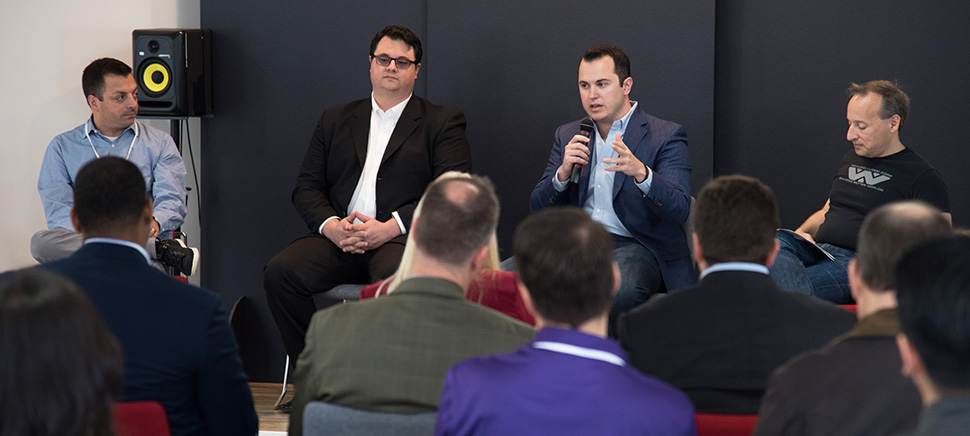VR TECHNOLOGY MAKING STRIDES IN NORTH TEXAS
The long-awaited breakthrough for virtual and augmented reality could be coming soon.
Both technologies have fallen short for several years, always promising big things, but continually failing to penetrate mainstream adoption.
Several experts in the field of virtual and augmented reality spoke at a Dallas Startup Week gaming session Wednesday morning, giving their visions of the future.
The North Texas region is a “nexus” for innovation in the field, which could become a billion dollar industry in the next few years, said Edward Lopategui, an aerospace engineer with PLM Innovation Entrepreneur, who moderated the panel.
Nick Dicarlo, vice president for immersive and virtual reality at Samsung Electronics America, said the latest technology tucks a smartphone into the goggles, dropping the user into a whole new world.
“With VR, the world surrounds you 100 percent, 360 degrees in all directions. It can trick your brain into thinking you’re in a different location.” – Nick Decarlo
“Everything that you’re used to seeing in terms of media is a rectangle,” said Dicarlo, referring to televisions screens, smartphones, and tablets. “With VR, the world surrounds you 100 percent, 360 degrees in all directions. It can trick your brain into thinking you’re in a different location. Now, you can travel the world in a game.”
One of the biggest innovations is the ability of the images to refresh so fast the user never sees a glitch as they turn their head.
The technology was most recently used at the NBA Final Four and NCAA men’s championship games, giving users a front-row seat at half court.
VR immerses users into an environment, but requires them to wear goggles. Users also can’t physically walk around without potentially hurting themselves by tripping over objects in the real world.
AUGMENTED REALITY OFFERS MULTIPLE WAYS TO IMMERSE CONSUMERS
By contrast, AR takes the real world and imposes digital images, pictures, and experiences on top of it.
This technology has implications for advertising, giving consumers a way to interact with digital commercials that get people interested in brand. This concept fits in with the emerging “experience economy,” where consumers care more about the rewards and experience they receive.
“You’ll have a higher ROI [return on investment] if you go back and focus on experience,” said Kevin Hart, CEO of Aireal, a company that specializes in augmented reality. “The more that experience evolves, the higher the return on investment will be.”
The result will be a virtual experience that taps into someone’s emotions.
“Businesses are racing to immerse all of your sensors into feeling their product more and more.” – Skip Howard
“Businesses are racing to immerse all of your sensors into feeling their product more and more,” said Skip Howard, CEO of Spacee. “I guarantee you’re going to see a major business push. Emotional connections transfer into sales.”
Howard is working on a different type of AR that doesn’t require goggles or a mobile device. Instead, physical equipment that projects virtual images and cameras that can listen to people’s requests is required.
He said this technology can only be used in a set location, such as a shopping mall.
“I’m hoping that ours will get mass adoption much quicker,” Howard said. “There’s no learning curve with ours. But, you have to install equipment in a physical space. There’s pros and cons of all of them.”
EDUCATIONAL OPPORTUNITIES EXIST FOR AUGMENTED REALITY
There are educational opportunities for AR, too. One could impose a fleet of aircraft in a field, have a large dinosaur in a gymnasium, or show what Times Square looked like in 1900.
For social media junkies, there’s the potential for individuals to create their own immersive experiences and share them. Think of a child’s birthday party that can be shared with friends and family members virtually.
“For me social and communication is an open green field opportunity,” Dicarlo said.
Of course, video games are one of the biggest drivers of VR and new technology is created all the time. This spring, Grand Prairie-based Six Flags will incorporate VR into a ride experience—The New Revolution Virtual Reality Coaster.
CHALLENGES EXIST FOR BOTH TECHNOLOGIES
But challenges still exist in getting mainstream adoption for both technologies.
An even bigger problem is that many people still associate VR with motion sickness, disorientation, and people falling or having accidents.
That’s the biggest challenge going forward, not necessarily who develops the next breakthrough.
“We care more about competing with ‘I don’t know, don’t care about it’, versus who is going to be successful,” Dicarlo said. “Anybody with a smartphone today becomes a VR user—that’s my goal.”
Schedule for Thursday, April 14
Schedule for Saturday, April 16
For a daily dose of what’s new and next in Dallas-Fort Worth innovation, subscribe to our Dallas Innovates e-newsletter.
































